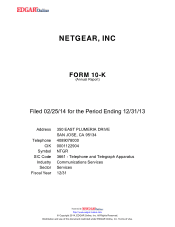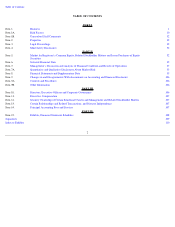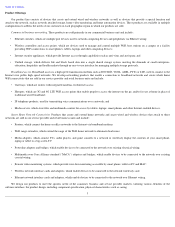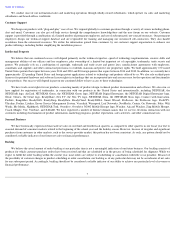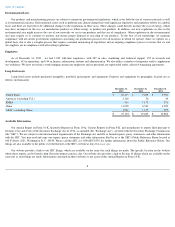Netgear 2013 Annual Report Download - page 8
Download and view the complete annual report
Please find page 8 of the 2013 Netgear annual report below. You can navigate through the pages in the report by either clicking on the pages listed below, or by using the keyword search tool below to find specific information within the annual report.
Table of Contents
Many of our existing and potential competitors have longer operating histories, greater name recognition and substantially greater financial,
technical, sales, marketing and other resources. As a result, they may have more advanced technology, larger distribution channels, stronger brand
names, better customer service and access to more customers than we do. For example, Hewlett-
Packard has significant brand name recognition and has
an advertising presence substantially greater than ours. Similarly, Cisco Systems is well recognized as a leader in providing networking products to
businesses and has substantially greater financial resources than we do. Several of our competitors, such as D-
Link, offer a range of products that
directly compete with most of our product offerings. Several of our other competitors primarily compete in a more limited manner. For example,
Hewlett-
Packard sells networking products primarily targeted at larger businesses or enterprises. However, the competitive environment in which we
operate changes rapidly. Other companies with significant resources could also become direct competitors, either through acquiring a competitor or
through internal efforts.
We believe that the principal competitive factors in the consumer, business and service provider markets for networking products include product
breadth, size and scope of the sales channel, brand name, timeliness of new product introductions, product availability, performance, features,
functionality and reliability, price, ease-of-
installation, maintenance and use, and customer service and support. We believe our products are competitive
in these markets based on these factors.
To remain competitive, we must invest significant resources in developing new products and enhancing our current products while continuing to
expand our sales channels and maintaining customer satisfaction worldwide.
Research and Development
As of December 31, 2013
, we had 355 employees engaged in research and development. Our success depends on our ability to develop products
that meet changing user needs and to anticipate and proactively respond to evolving technology in a timely and cost-
effective manner. Accordingly, we
have made investments in our research and development department in order to effectively evaluate new third-party technologies, develop new in-
house
technologies, and develop and test new products. Our research and development employees work closely with our technology and manufacturing
partners to bring our products to market in a timely, high quality and cost-efficient manner.
We identify, qualify or self-
develop new technologies, and we work closely with our various technology suppliers and manufacturing partners to
develop products using one or more of the development methodologies described below.
ODM.
Under the ODM methodology, we define the product concept and specification and recommend the technology selection. We then
coordinate with our technology suppliers while they develop the product meeting our specification. On certain new products, one or more subsystems of
the design can be done in-
house and then integrated with the remaining design pieces from the ODM. Once prototypes are completed, we work with our
partners to complete the debugging and systems integration and testing. After completion of the final tests, agency approvals and product
documentation, the product is released for production.
In-House Development. Under the in-
house development model, one or more subsystems of the product are designed and developed utilizing the
NETGEAR engineering team. Under this model, some of the primary technology is developed in
-
house. We then work closely with either an ODM or a
contract manufacturer ("CM") to complete the development of the entire design, perform the necessary testing, and obtain regulatory approvals before
the product is released for production.
OEM.
Under the original equipment manufacturer ("OEM"), methodology, which we use for a limited number of products, we define the product
specification and then purchase the product from OEM suppliers that have existing products fitting our design requirements. In some cases, once a
technology supplier's product is selected, we work with the OEM supplier to complete the cosmetic changes to fit into our mechanical and packaging
design, as well as our documentation and graphical user interface ("GUI") standard. The OEM supplier completes regulatory approvals on our behalf.
When all design verification and regulatory testing is completed, the product is released for production.
Our internal research and development efforts focus on developing and improving the usability, reliability, functionality, cost and performance of
our products. Our total research and development expenses were $85.2 million in 2013 , $61.1 million in 2012 and $48.7 million in 2011 .
Manufacturing
Our primary manufacturers are Cameo Communications Inc., Delta Networks Incorporated, Hon Hai Precision Industry Co., Ltd., (more
commonly known as Foxconn Corporation), Sercomm Corporation, Pegatron Corporation (which was spun out of ASUSTek Computer, Inc. in January
2008) and Wistron New Web Corporation, all of which are headquartered in Taiwan. We also use FLEXTRONICS with headquarters in Singapore and
the United States. The actual manufacturing of our products occurs
5

